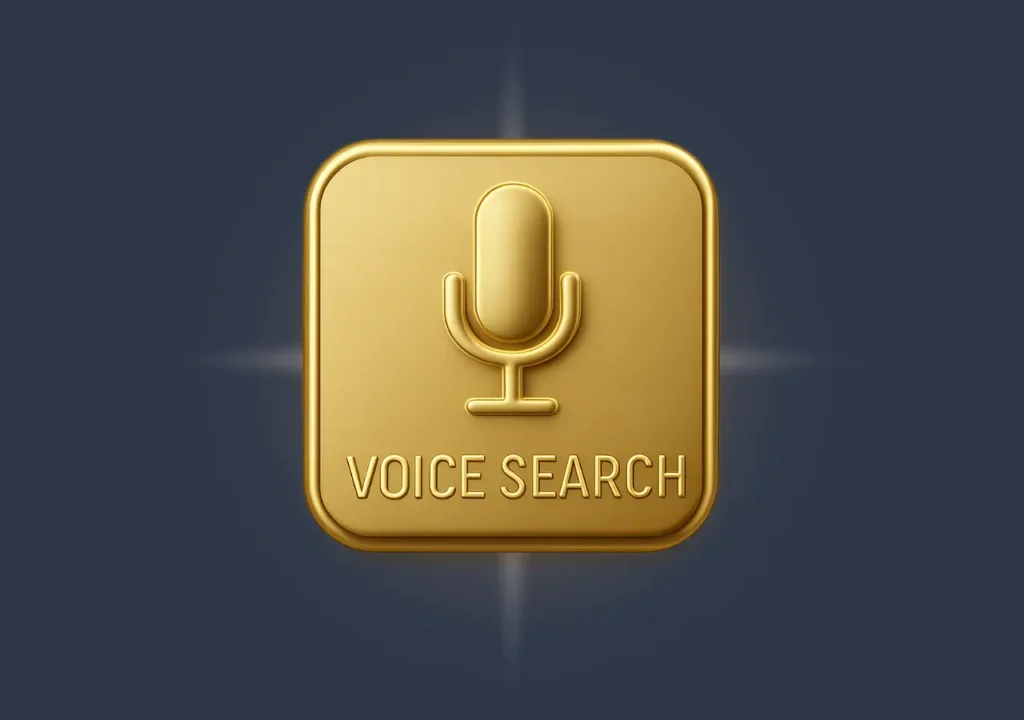

Why voice search is no longer optional — the big picture 🌐
Okay, here’s the thing: voice search isn’t a niche anymore, it’s a full-on channel — loud and clear. Devices, apps, smart speakers, car assistants — they’re everywhere, and people are getting used to asking out loud instead of typing. Sounds obvious, right? But the pace is surprising: more natural language queries, more local intent, and a ton of mobile-first interactions. For bloggers that means the old “keyword stuffing” tricks just don’t cut it; conversational search looks for answers, context, and trust — fast.
So what changes? First, search behavior becomes more question-driven — think “How do I…?” or “Where’s the best…?” — rather than fragment keywords. Second, SERP layouts evolve: featured snippets, quick answers, and audio playback can steal clicks (and eyeballs). And third, user expectations are different — they expect quick, direct, and trustworthy responses. This is the new baseline.
Key shifts to watch
- Conversational queries replace terse keywords.
- Local and transactional intent increases (think “near me”).
- Featured snippets and structured results dominate attention.
Understanding conversational intent — talk like people do 🗣️
Voice queries are sentences. Full sentences. Weird, I know — but it matters. People ask follow-up questions, they use pronouns, they omit punctuation, and they expect continuity (so context matters). For bloggers, the goal is to match that tone and structure: short, direct answers followed by helpful detail. Sounds simple, but it’s an art (and a little science).

One tip: think in Q&A. That’s not new, but with voice it’s essential. Put concise answers at the top of sections, then expand for depth. Why? Because voice assistants often scrape the first 40–60 words for a spoken reply. So lead with a clear one-sentence answer, then give context, examples, or links. Also, remember to use variations — people ask the same thing in many ways, so cover synonyms and casual phrasing (definately include “how do I”, “what is”, “can I”, etc.).
Quick practice
- Write the question as an H3 or H4.
- Put a 1–2 sentence answer immediately after.
- Add a short paragraph for depth, links, and sources.

Optimize for featured snippets and “spoken” answers 🎯
Featured snippets are the bread and butter of voice results — get there and your site can be read aloud. But it’s not just SEO-voodoo; it’s structure and clarity. Use lists, tables, and short paragraphs. Use schema where relevant. And seriously, put TL;DRs at the top of posts (short, crisp, and snappy — perfect for voice assistants to read).
Another thing: numeric and step-based content performs great for voice. Recipes, how-tos, timelines, and product comparisons — these fit a spoken format. When you format a how-to as a clear, numbered list, you increase the chance that a virtual assistant will narrate the steps. Also, use FAQ schema to mark question-answer pairs, and try the Speakable schema for key paragraphs if it fits your CMS. Hmm… small caveat: not all platforms honor speakable tags, but many do (and it’s worth the shot).
Checklist for snippets
- Short answer first (40–60 words).
- Use numbered or bulleted lists for procedures.
- Add structured data: FAQ, HowTo, Speakable.
Local voice search — the goldmine for bloggers with local audiences 📍
Local voice queries are huge — people ask “near me” while driving, shopping, or on a coffee break. For local bloggers (food, events, city guides), this is a direct traffic source. Make sure your NAP (name, address, phone) is consistent, your Google Business Profile is sharp, and that you pepper location-based variants through your content naturally (don’t overdo it, though — that feels spammy).

Also, feature local intent in your headings: “Best brunch spots near X” or “How to get to Y from Z.” Add short, spoken-friendly answers for opening hours, directions, and must-mentions. Voice users want quick, actionable info — hours, wait times, menu highlights. If you can answer those in one line, your blog could become the assistant’s go-to citation. Not bad, right?
Local life hacks
- Update and verify your Google Business Profile.
- Embed schema for localBusiness and openingHours.
- Create short “quick facts” blocks for voice-readables.

Content format and structure — write like you speak (but tidy) ✍️
This is where many bloggers trip up — they over-edit and kill the natural voice. Voice search rewards conversational clarity, so write in a friendly, human tone. Use contractions, rhetorical questions, and short sentences (yep, fragments allowed). But also keep it organized: headings, short paragraphs, and clear lists are your best friends. Think of each subheading as a possible voice cue.
Another pro tip: add micro-summaries and “fast answers” at the top of posts — bullet shorties that an assistant can read quickly. Then expand with longform content for readers who want depth. You get both audiences: the one who wants a 10-second answer and the one who wants to binge-read for 20 minutes. Win-win. Also, include synonyms and natural language variants inside the body — that helps capture the many ways people ask the same thing.
Formatting hacks
- Put short answers directly under questions.
- Use lists and bold key terms for scannability.
- Embed transcripts for audio/video content.
Technical must-haves — speed, schema, and accessibility ⚙️
Fine content is nothing without good tech. Voice assistants favor sites that load fast and are mobile-optimized. So optimize images, implement lazy loading, and reduce render-blocking scripts. Seriously, page speed is the currency here — shave off milliseconds where you can. Also, use schema (FAQ, HowTo, Speakable) so crawlers can easily parse your answers and present them to voice platforms.

Accessibility matters too. Use semantic HTML (heading hierarchy, alt text, ARIA where needed). Voice platforms often rely on structured markup to find quick answers. If your content is chaotic, it won’t be read aloud. And don’t forget SSL — security signals still matter for ranking and trust. Lastly, set up analytics to track voice referrals (ask Google Analytics to segment by device, and use query analysis to spot conversational phrasing).
Technical checklist
- Optimize mobile page speed (Core Web Vitals).
- Implement FAQ/HowTo/Speakable schema.
- Keep semantic HTML and accessible markup.

Measuring success and experimentation — be a curious scientist 🧪
Voice search tracking can feel fuzzy, but you can still measure and iterate. Track impressions for conversational queries, monitor featured snippet wins, and segment organic traffic by device. Use tools that surface question-style keywords (some SEO tools now show “natural language queries”). Run small A/B tests: change a heading, add a short answer, and watch snippet ownership — you’ll be surprised how often small edits influence voice pickups.
Also, record real user experiments where possible — ask friends or colleagues to use voice queries and see what answers appear. Does your site show up? If not, tweak. The goal is to build repeatable hacks that yield voice citations. And remember: patience. Search changes slowly (even when it seems fast), so keep testing and keep records.
Metrics to watch
- Featured snippet wins and changes over time.
- Voice-related query impressions (question phrases).
- Local pack citations and Google Business interactions.
Practical life hacks for bloggers — quick wins you can do today 🛠️
Alright, time for the fun part — quick, actionable hacks you can implement this afternoon (no fluff). First: add an FAQ section to your top posts with crisp answers. Second: craft a “one-line answer” at the top of each major heading. Third: convert top-performing posts into short audio clips and include transcripts (voice loves audio plus text). Easy stuff, yes? But impactful.

Here are some fast moves:
- Audit your top 10 posts — add 1–2 Q&A pairs each.
- Rewrite lead paragraphs to answer probable voice questions.
- Use Schema markup on updated pages (FAQ/HowTo).
- Create a “quick facts” box with 1–2 sentence answers.
- Test your answers with Siri, Google Assistant, and Alexa.
Do these consistently and you’ll see small wins stack up over weeks. Patience + focus = results. Oh, and keep a note of odd queries — they make great content ideas later.

Final thoughts — adapt, don’t panic (but do act) 🚀
Voice search is a shift in how users express intent, not a replacement for typed search. For bloggers, that’s good news — authentic, helpful content still wins. The trick is to format and tune your posts for conversational pickup: short spoken answers, structured pages, and smart use of schema. Be human, be clear, and be quick. Sounds simple, but it’s rare (so there’s opportunity).
So — take small steps, test often, and prioritize the user experience. You’ll build a site that both humans and machines prefer. And hey, if you’re still typing “coffee shop near me” into a search bar in 2025, you’re probably doing it wrong — but you’re not alone. Keep iterating, keep listening (literally), and you’ll be in a good spot.
❓ Voice Search FAQ
Because it has become a mainstream search channel. People now use smart speakers, phones, and car assistants daily. Ignoring it means missing users who prefer asking questions out loud instead of typing.
Voice queries are longer and conversational. Instead of typing “best coffee shop,” users say “Where’s the best coffee shop near me?” They expect clear, direct answers, not keyword-heavy pages.
Because voice assistants look for natural language. If your content matches human speech patterns, it’s more likely to be read aloud in search results.
Featured snippets are often the answers that assistants read aloud. Structuring your content with clear, short answers increases your chances of being the chosen response.
Keep your Google Business Profile updated, ensure your name, address, and phone number are consistent, and add natural location-based phrases like “near me” into your content.
Fast-loading, mobile-optimized pages are critical. Adding schema markup (FAQ, HowTo, Speakable) and keeping semantic HTML clean helps search engines parse and deliver your answers.
Write in a conversational tone with short answers under questions. Use lists, headings, and bullet points. This makes your content scannable and easy for assistants to read aloud.
Track impressions for question-based queries, monitor featured snippet wins, and analyze mobile and smart-device traffic. Running small A/B tests also shows which answers perform best.
Add FAQ sections to your posts, create one-line answers for major questions, and use schema markup. Test your content with Siri, Alexa, or Google Assistant to see what gets read.
Voice search won’t replace text search but will continue to grow. Bloggers who adapt content for conversational queries, fast answers, and structured data will gain more traffic and trust.
This article was prepared using the AUTO-POST-SEO plugin






